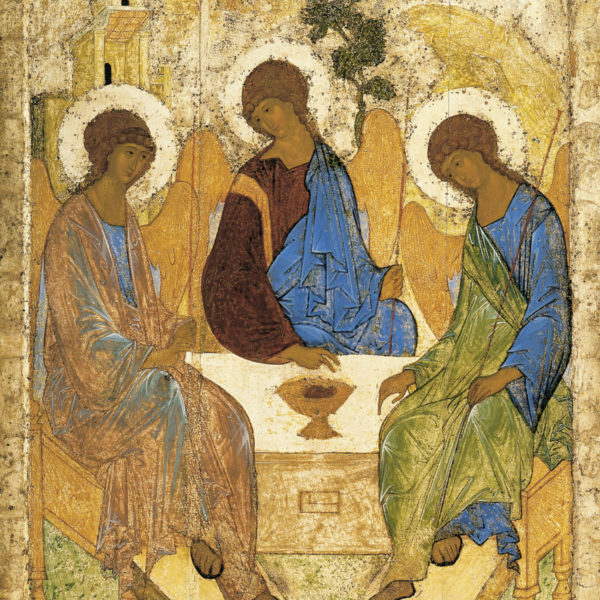
The Holy Trinity, Year C (6/16/2019)
Proverbs 8:1-4, 22-31
Psalm 8
Romans 5:1-5
John 16:12-15
Click the play button to listen to this week’s sermon.
Our theological formulations inevitably fall short of capturing the truth of God. But our formulations are means of glimpsing the truth, of perceiving the one who makes and heals and enlivens the world. Earnest theology both acknowledges its own limitations and delights in bearing witness to God alive in our midst.
Holy Trinity Sunday is the only festival of the church year that’s named for a theological doctrine. Why, you might ask, does the church preserve a date on the liturgical calendar to reaffirm an ancient and seemingly impossible idea? God is one, yet God is somehow three, still God is ultimately one. Of course, reason alone cannot apprehend the Trinity, which confounds modern people to the extent that we mostly ignore the theology. Art and analogy approximate the Trinity through representation, and these approximations are often beautiful and compelling. For instance, medieval Russian painter Andrei Rublev imagines the Holy Trinity in terms of the three mysterious figures who visit Abraham and Sarah by the oaks of Mamre.[1] Abraham and Sarah receive them with reverence and hospitality, and the strangers speak to them prophetically and with a unified voice. This representation along with many others – the Trinity knot, the three-leaf clover, the image of Lover, Beloved, and Bond of Love – these help us grasp at God’s identity, yet each one falls short of the truth.
If God is finally ineffable, might we simply dispense with the doctrine of the Holy Trinity altogether? The modern age has not been kind to theological definitions that insist on their legitimacy solely on the basis of tradition or institutional acceptance. It’s not enough to affirm that the church has long promoted the doctrine of the Trinity, and leave it at that. No, our language about God can’t be encased in categories that stand apart from our lived experience. The Trinity has to mean something real to us.
But neither should we reject any and all doctrine as too concrete to touch on the mystery of God. Christian Wiman puts it this way: “We do not need definite beliefs because their objects are necessarily true. We need them because they enable us to stand on steady spots from which the truth may be glimpsed …. Definite beliefs are what make the radical mystery – those moments when we suddenly know there is a God, about whom we “know” absolutely nothing – accessible to us and our ordinary, unmysterious lives.”[2]
In other words, the doctrine of the Trinity is a shrine, like a pile of stones to mark a holy place. It’s a built structure that invites us into the possibility of encountering the One who cannot be confined to structures.
The question remains: What truth does the doctrine of the Holy Trinity evoke? How does it resonate with us in 2019? The biblical texts assigned for today are bursting with the desire to communicate the Trinity’s meaning, striving to capture in words the love and joy that flow from the heart of God to the world. God the Creator fashions and refashions the cosmos, yet never loses sight of the lowly creature: “When I consider your heavens, the work of your fingers, the moon and the stars you have set in their courses, what are mere mortals that you should be mindful of them, human beings that you should care for them?” The Word, the Wisdom of God, partners with the Creator from the beginning to lavish divine love on the world: “Then I was beside him, like a master worker; and I was daily [God’s] delight, rejoicing before him always, rejoicing in his inhabited world and delighting in the human race.” And, like a gentle wind, the Spirit of God blows in and through the world to direct us back to God: “When the Spirit of truth comes, she will guide you into all the truth….”
These expressions are the poetics of faith, images of the love that pervades the divine life, the same love that God extends to us amid the fractured circumstances of our lives. If God is Father, Son, and Holy Spirit, this language is only to draw us more closely into relationship with the source of all goodness, which is itself characterized by relationship – One in Three together and Three together in One, and all for the sake of love.
Dear church, our theological formulations inevitably fall short of capturing the truth of God. But our formulations are means of glimpsing the truth, of perceiving the one who makes and heals and enlivens the world. Earnest theology acknowledges its own limitations, recognizing that “all of our doctrines are best efforts, at best,” to quote Karoline Lewis.[3] But earnest theology, attentive to the Spirit’s prompting, also delights in the pursuit of truth, never neglecting to bear witness to God alive in our midst.
[1] Genesis 18:1-15.
[2] My Bright Abyss, 123.
[3] “Trinity Musings,” http://www.workingpreacher.org/craft.aspx?post=5354.

